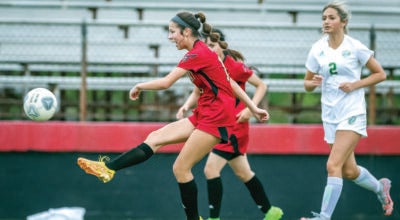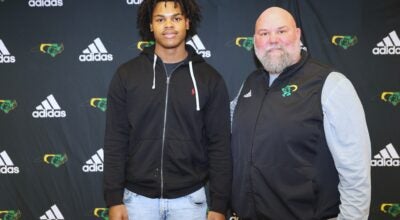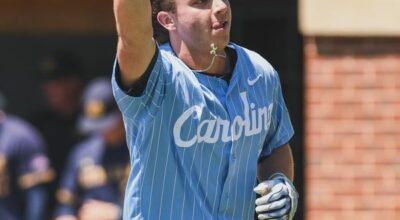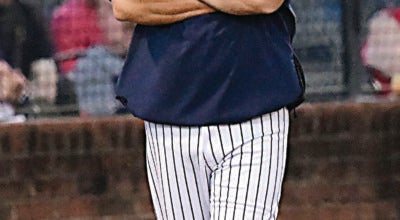Hall of Famer Frank McRae dies
Published 12:00 am Tuesday, June 28, 2016

- Salisbury post archives Frank McRae was a Rowan County standout in high school baseball, Legion baseball and basketball. He helped Wake Forest University win the 1955 College World Series.
SALISBURY — Bob Waggoner was Frank McRae’s teammate at Salisbury’s Boyden High and on the 1955 Wake Forest team that won the College World Series, and he still remembers the bat McRae used to smash baseballs as hard as anyone from Rowan County ever hit them.
McRae’s bat was the Eddie Mathews model produced by Adrirondack — 35 inches and 33 ounces. McRae would choke up about an inch, Waggoner recalls, and he found a precise balance and a devastating swing.
“I played against Frank and I also played with him, and Frank hit balls as hard as any individual I ever saw, and I saw a lot of baseballs hit,” said Billy Ray Barnes, the Landis High product who starred in the NFL and was McRae’s baseball teammate at Wake Forest.
McRae, a big man who could move, passed away at 81 on June 9, one day shy of the 61st anniversary of Wake Forest’s opening game in the 1955 World Series against Colgate at Omaha’s Rosenblatt Stadium.
McRae’s shining moment would come in Omaha on June 16 when Wake Forest, with three Rowan County players — McRae, Waggoner and Barnes — in the lineup, beat Western Michigan, 7-6, for the championship. McRae went 5-for-5 at the plate. He drove in three runs and made the diving catch in left field that maintained Wake Forest’s slim lead.
“Frank had gone through a lot of injuries by then,” Waggoner said. “But we needed his bat in the lineup, and he had a good eye in the outfield. He always could tell where a ball was going, and he made that great catch to preserve our lead.”
The joy of that unexpected victory in Omaha by the little Baptist school got more meaningful for the players as the years rolled by.
“You talk about a thrill,” Barnes said. “Three of us from little ol’ Rowan County, hell, we didn’t even know where Omaha was. We’d never had a plane ride before that. And then we go out there and win it all? I know it was as big a thrill for Frank as it was for the rest of us.”
McRae’s athletic ability was evident when he was 14 years old. He was playing for the Salisbury American Legion team against Spencer in 1949 when he socked a pitch over the 353-foot sign in left field at Newman Park.
He hit four homers that summer in days when hitters swung wood and longballs were rare. Two of McRae’s homers soared to dead center field.
McRae batted .294, .447 and .385 in his three American Legion seasons. In four varsity seasons at Boyden, he batted .350, .323, .402 and .427.
He swatted six high school homers and 17 more in Legion, and he also was an exceptional pitcher. He hurled a no-hitter and a one-hitter during the 1951 American Legion season.
“He hit some over the trees at Newman Park with a wood bat, and to do that with wood is significant,” Waggoner said. “The power Frank had as a young guy was amazing, and he was a great pitcher with a good curveball and fastball. He could play about any position on the field. He played shortstop well and he was very good in the outfield.”
McRae’s talented wasn’t limited to the baseball diamond. At 6-foot-3, he was one of the best basketball players in the North Carolina high school ranks. Playing for coach Derwood Huneycutt at Boyden, McRae broke the school record as a senior in 1952 by scoring 42 points in a 69-52 win against Asheville.
That 42-point outing remained the school scoring record for Boyden and Salisbury until Shamari Spears scored 43 against Lexington in 2003.
McRae scored 34 against R.J. Reynolds and 32 against Gastonia. After scoring 407 points and averaging 19.4 points as a junior, McRae scored 489 as a senior and broke the conference record. He averaged 23.3 points per game.
McRae broke the county career scoring record with 1,199 points, although that mark wouldn’t last long. Barnes would surpass McRae’s mark the next winter.
McRae was named to five All-State teams, two for high school baseball, one for American Legion baseball and two for high school basketball.
His final high school basketball game, the 1952 East-West All-Star Game, marked another outstanding performance by McRae.
“They had a lot of big men, so they asked Frank to play guard,” Waggoner said. “He passed the ball to his teammates well, took the right shots. I remember the lady sportswriter from Winston-Salem (Mary Garber) writing that Frank was the best player on the floor.
The baseball draft wouldn’t be implemented until 1965. In 1952, professional teams could make offers and sign players as soon as they’d graduated from high school.
When McRae graduated, he had pro baseball offers for serious bonus money as well as college scholarship offers to play basketball and baseball.
“Frank’s dream was always to play pro baseball, and that’s what he’d always prepared himself for, but his family wanted him to put his education first,” Waggoner said.
McRae heeded his father’s wishes. He said no to pro baseball. Then he chose Wake Forest, one of the schools that wanted him to play two sports.
Freshman were eligible for the 1952-53 basketball season, and McRae saw quite a bit of action for Wake Forest. He was playing behind star Dickie Hemric, however, and the 6-foot-6 Hemric would go on to become the leading scorer in school history.
“I remember Hemric getting hurt and Frank going in there and doing a hell of a job,” Barnes said.
But it was in baseball where McRae would shine in the 1954, 1955 and 1956 seasons.
In 1955, Wake Forest’s championship season, McRae had 42 hits and broke the ACC record — the ACC was a young league then — with 34 RBIs.
“The injuries were starting to pile up on Frank,” Waggoner said. “He’d hurt his shoulder so badly he could barely lift his right arm and he tore up his ankles, but he always played through it.”
Prior to the 1956 season, Wake Forest switched the positions of Waggoner and McRae. Waggoner had played first base superbly on the World Series team, but he moved to left field. McRae shifted from left field to first base, so he wouldn’t have to make long throws.
“I remember we were playing down at South Carolina and Frank hurt his ankle so badly he was hospitalized,” Waggoner said. “He got a call saying he needed to get back to Wake Forest right away to take an exam — at Wake Forest, they didn’t cut the athletes any slack on academics. Frank limped out of the hospital without telling anyone and bummed (hitch-hiked) his way back to Winston-Salem to take that test. I don’t know how he did it, but he did.”
Even with his running speed diminished and his throwing shoulder wrecked, McRae could still swing a bat. He hit .419 as a senior to win the ACC batting title. He went 31-for-74. Wake Forest wouldn’t have another .400 hitter until the 1980s.
“Frank was suffering physically, but he could level the ball,” Waggoner said. “Not a lot of home runs, but he consistently hit the ball hard.”
McRae was a gentle giant, well-liked on and off the field.
“Just a very well-rounded guy,” Waggoner said.
His injuries at Wake Forest kept McRae from getting a second chance at playing pro baseball, but he’s remembered as one of the best of his era. He still has a presence in the Rowan County and Wake Forest record books, and when the College World Series rolls around every June, someone mentions McRae’s 5-for-5, one of the greatest clutch performances of all-time.
McRae entered the Salisbury-Rowan Hall of Fame in 2008.
“He’s one of the finest athletes ever to come out of Salisbury and Rowan County,” Barnes said. “No one could hit a baseball like Frank McRae.”





